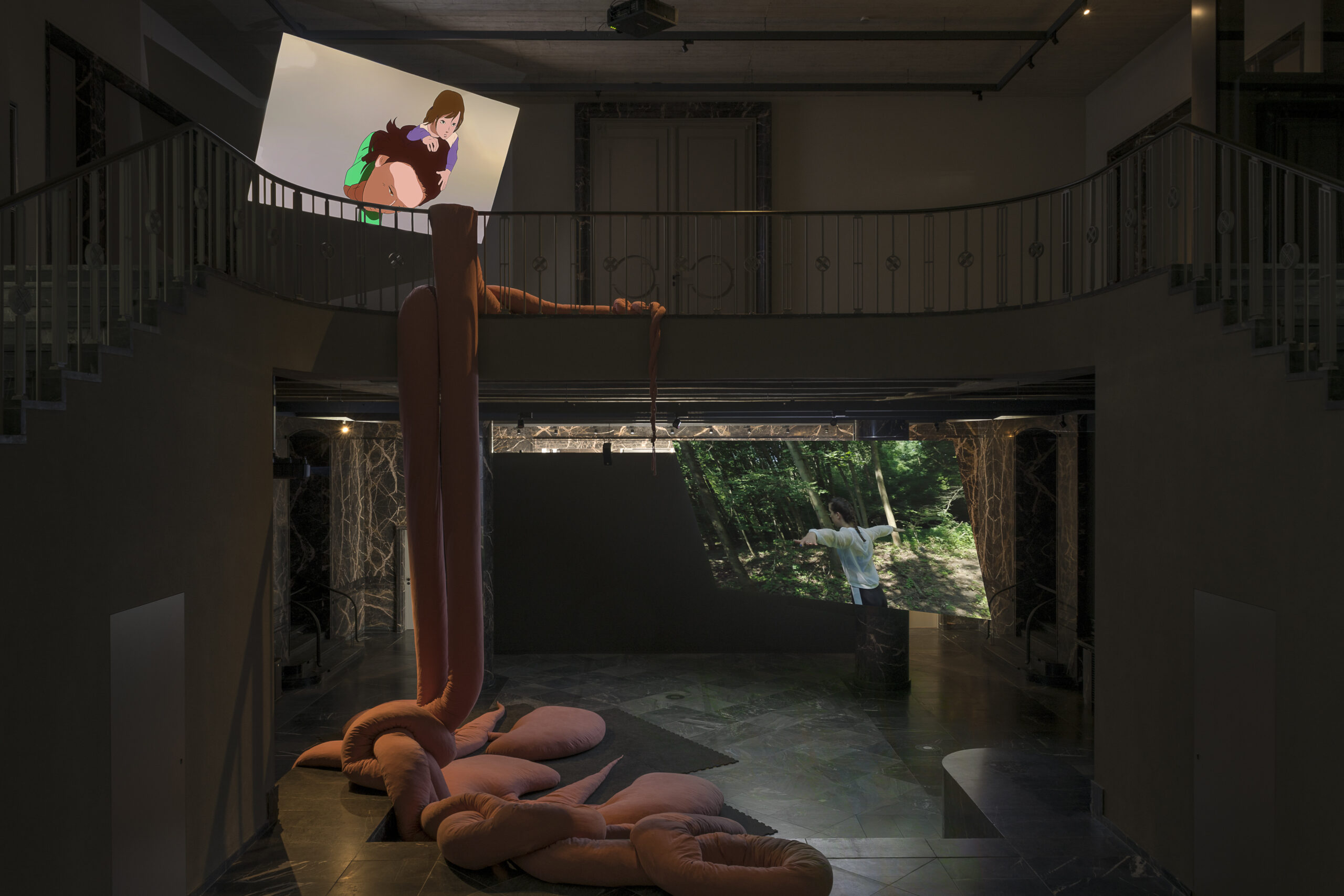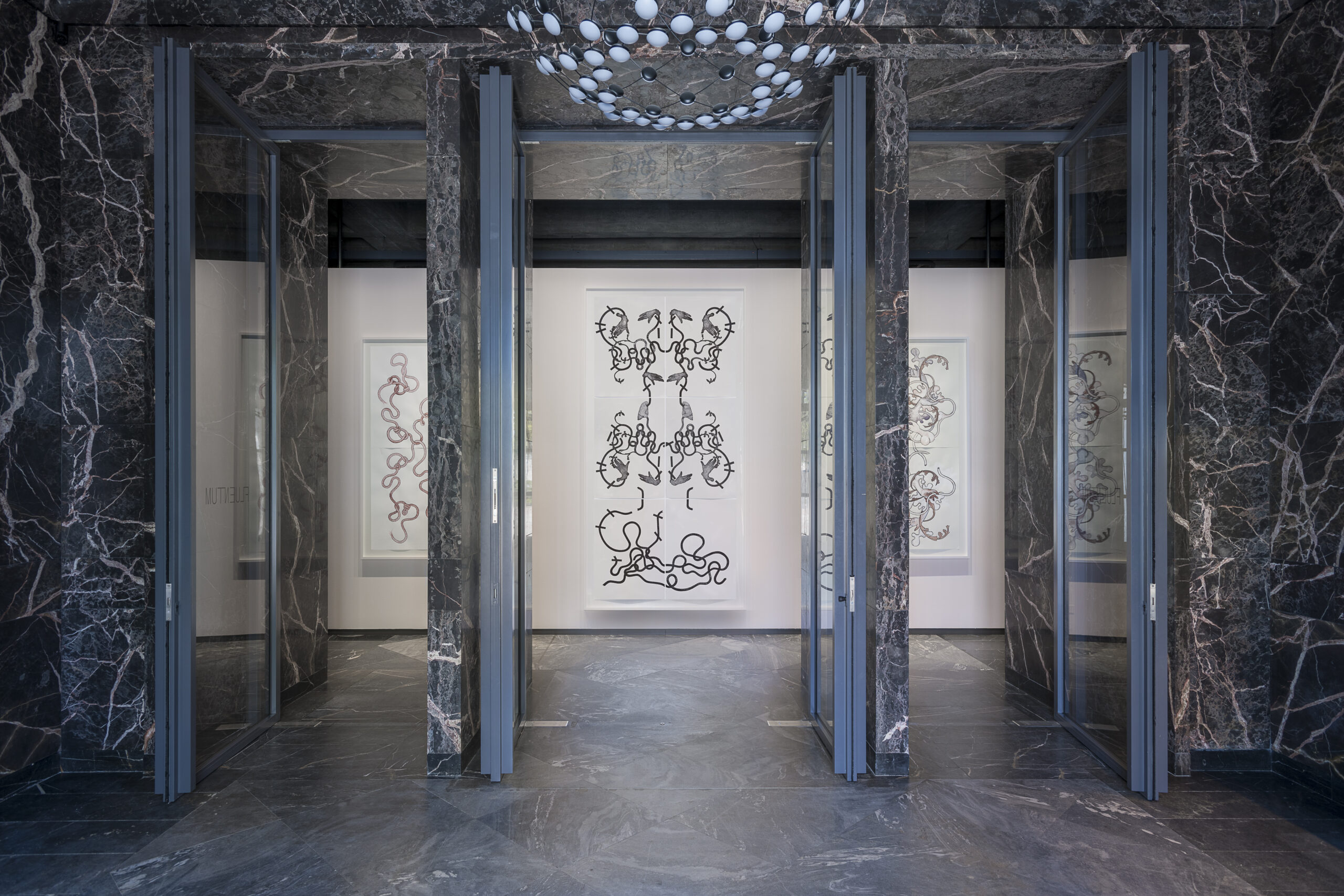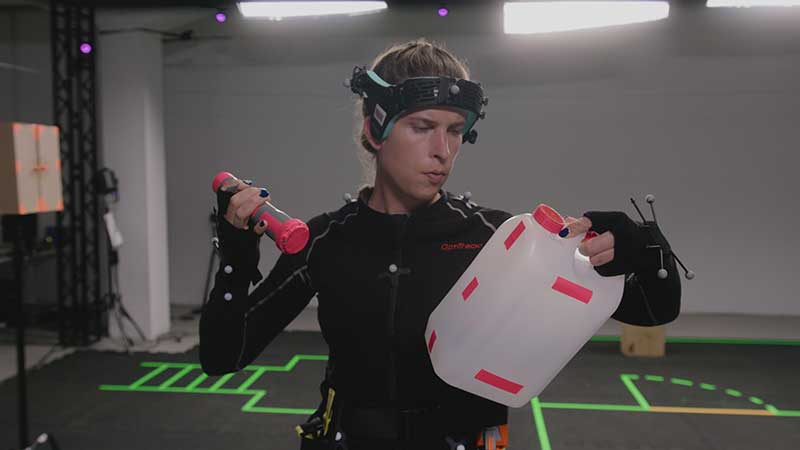by Cristina Ramos // July 7, 2022
Anja Kirschner is an artist working predominantly with moving images. Her work examines the immersive conditions of contemporary lifeforms and the role materiality, technology and narrativity play in their deformation and re-figuration. ‘UNICA’ is the title of her recent solo exhibition at Fluentum, Berlin. It refers to the artist and writer Unica Zürn (1916-1970), whose body of work combines anagrammatic poetry and intricate drawings to reinvent the idea of the self. We talked with Kirschner on the occasion of the exhibition which can be viewed until July 16.

Anja Kirschner: ‘UNICA,’ installation view, 2022, Fluentum, animation by Diana Gradinaru // Photo by Stefan Korte
Cristina Ramos: The title of the exhibition bears the name of Unica Zürn, an artist who engaged Surrealist techniques of drawing and writing. What triggered the choice to have her so present in the exhibition?
Anja Kirschner: The exhibition isn’t about Unica Zürn in a biographical sense. The large scale drawings one encounters upon entering the exhibition were rather a way of processing Zürn’s anagrams and drawings on my own terms. The title ‘UNICA’ could be understood as the name of the generative principle or algorithm I derived from this engagement with her work. At the time of making the drawings I was also influenced by Larry Mitchell’s ‘The Faggots & Their Friends Between Revolutions’ (1977) and the way the book’s protagonists mobilise “the domestic arts” against the violent exclusions of “the public arts.” Under the competence of ‘The Faggots & Their Friends,’ domestic spaces become sites of communal living in which queer solidarity, sociability and survival are practised daily in many forms. As a result the drawings presented as part of ‘UNICA’ have more in common with wallpaper and fabric designs, which, on closer inspection, mutate over their repetition, forming and loosening intricate patterns composed of “organs, tubes, intestines, butts, creepers, hands with testicles,” as one of the protagonists in the video installation describes them.

Anja Kirschner: ‘UNICA,’ Installation view, 2022, Fluentum // Photo by Stefan Korte
CR: When reflecting upon the exhibition display I wonder if there is any correlation with the digital world, dual-screen phones, or computer interfaces?
AK: The way I conceived the installation was derived from Zürn’s illustrated text ‘Das Haus der Krankheiten’ (‘The House of Illnesses’) which she wrote in 1958. In the narrative and the accompanying drawings, Zürn imagines her body and its institutionalisation as one formation: an immersive architecture with rooms made of body parts and organs, which she navigates but which are also hers (and others’). Zürn’s figuration of the House of Illnesses allowed me to develop a notion of immersion that does not rely on an oppositional conception of simulated versus actual events, but instead pays attention to their entanglements. In ‘UNICA,’ an expanded notion of the algorithmic becomes key to mapping, navigating and traversing (in the sense of “crossing with difficulty, going against”) the ways in which something like a body and something like an environment are formed, together with the codes and violences that perpetuate themselves in and through such formations. If Zürn’s House of Illnesses is understood as having a non-arbitrary relation to the house (and by extension the hospital or mental institution), as an immersive technology for shaping and disciplining a Western version of female sex-gender, with technology here understood in the broader sense of cultural technology, then ‘UNICA’ offers ways of mapping, navigating and hacking the codes that govern it.
The algorithmic is taken up as a generative principle which governs the work as a whole and produces repetition with variation. It is derived from the operations Zürn deployed in her drawings and writing, in particular her anagrammatic poetry and her re-ordering of bodies and architectures alongst related lines. To give just one concrete example, in the first video one encounters upon entering the exhibition space is a performer (played by Grete Gehrke) in a motion capture studio. She is recording scenes for a postapocalyptic computer game in which she must navigate through an abandoned house. These scenes are transposed and repeated in what looks like a natural landscape, but it is in fact an artificial one—a hill at the edge of Berlin called Teufelsberg, which was made out of the rubble of buildings destroyed in WWII and then planted over with trees. In the motion capture studio the performer is collecting items for her survival, a generic feature of many post-apocalyptic computer games: a gun, batteries, medication, a petrol canister. At Teufelsberg the same operations lead her to uncover shards of broken crockery, bricks and rusted metal from the forest floor. I was focused on the way the two sites formed something like a feedback loop: the codified ways of operating in the motion caption studio make it possible for the forest to be perceived as a destroyed city, an artificial naturalisation of a catastrophic event; and the post apocalyptic game setting now no longer appears as a future-likely scenario, but something constituted by a catastrophe that has already happened.

Anja Kirschner: ‘UNICA,’ 2022, video still // Copyright Anja Kirschner.
CR: Zürn’s practice unfolds characters and landscapes defined by organic shapes that seem to be growing one into another. For instance, it is very difficult to follow a single line in her drawings without being lost in an amalgamation. Is the storytelling of your video works informed by this aspect?
AK: Zürn’s intricate drawings do not have a centre but expand on the page in all directions, and one can imagine that they could keep doing so. Their concern is not with a display of virtuosic draughtsmanship, but with the figuration of states that are resistant to resolution through critical, clinical and even surrealist discourses. This is very apparent in the drawing ‘Plan des Hauses der Krankheiten’ (‘Plan of the House of Illnesses’) (1958), which strikes me more as an annotated map by which to navigate an immersive organismic-cum-institutional architecture, than an illustration to a story created primarily for aesthetic consideration. In my video works I retroactively read Zürn’s approach through the ways in which immersive technologies such as VR and gaming inflect moving image today, provoking a shift from storytelling to navigation. Moving image has been predominantly understood as a time-based medium but in ‘UNICA’ I wanted to produce a work that has to be approached in terms of space rather than time, and that operates through navigation rather than narration.
Exhibition Info
Fluentum
Anja Kirschner: ‘Unica’
Artist Talk and Catalog Launch: Saturday, July 16; 4pm
Exhibition: Apr. 11–July 16, 2022
fluentum.org
Clayallee 174, 14195 Berlin, click here for map





















